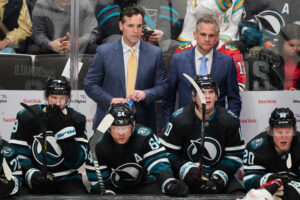Even without the Unfortunate Interruption That Shall Remain Nameless, there were questions around the Vancouver Canucks forwards next season. Would they be able to keep Tyler Toffoli? Was Adam Gaudette for real? Will the Canucks trade Jake Virtanen? Where will the team’s free agents end up?
Ends up the answers were “No” “Maybe” “Apparently Not” and “Calgary” so let’s go find some more questions.
No Buyouts for the Vancouver Canucks Forwards
The Canucks didn’t bother to avail themselves of the initial buyout period, which telegraphed their intentions for the next cycle. The only player to take them to arbitration has signed, with Virtanen agreeing to terms on Thursday. While there are a few free agents remaining, those are AHL or fringe NHL players. They can get a shot in the 2021(?) season, but won’t affect the team greatly. All the bad contracts the Canucks carried into the season are still on the team. The young forwards who were close to making it to the big club were already there.
The team is already well over the salary cap, so the missed buyout opportunities surprised some fans. Arguments could be made for or against their use, but it was always an unlikely decision for owners who have lost huge amounts of money this year. Conversations are ongoing about when the league will start again – with or without fans. The appetite for paying athletes to not play for your team isn’t large. And with the team still under construction, general manager Jim Benning is reluctant to move future assets just to gain cap space for one or two years. In short, what we see now – barring a major deal – is what we’re getting.
The Set-Up
The Canucks currently have 15 forwards signed to NHL contracts. This isn’t including restricted free agent Justin Bailey, NCAA graduate Marc Michaelis, or new acquisition Jayce Hawryluk. That alone is reason to suspect at least one of them is getting moved. Two factors work against any such move, however.
The first is that whatever format is introduced for the next season, it will certainly contain a compressed schedule. The league wants enough games to satisfy the last year of its television contract with NBC. And NBC wants them to finish, including playoffs, in time for the Olympics. It seems that the two previous seasons of 48 games (1994-95 and 2012-13) is a minimum target. Even so, that will carry the league into summer once again, bumping against the planned Olympic start in late July. Teams want more than that, increasing the chances of getting fans into the arenas for actual games.
If possible, even at quarter capacity, that’s roughly $400,000 per game in ticket sales alone for the Canucks. There are obviously costs associated with running Rogers Arena as well. Games played in empty arenas, even temporarily, is not sitting well with owners. They are agitating for all contracts to be prorated, matching the number of games played. The players disagree, of course, arguing that they are already playing for 72% of their signed contracts.
So, a compressed schedule is virtually guaranteed. And a massive reduction of incoming cash, even under the best of conditions, is also a guarantee. How are these two things going to affect the Vancouver Canucks forwards? Glad you asked!
The Payoff
If nothing extraordinary should happen, then teams will have to get under the cap. There are several ways they can do this. One is by trading contracts away – and buying high for precious cap space. Taking this course sends prospects, draft picks, current players, or some combination to accompany the burdensome deal. Not a great choice for a team that’s not yet ready to compete for the Stanley Cup.
An ideal target here could be Loui Eriksson: he is still a perfectly decent defender, even as his offence has vanished. His cap hit is a wildly unreasonable $6 million per season for two more years. His actual cash salary, on the other hand, is $5 million in total. Still not great for a defensive specialist, but not too savage, especially if the Canucks retain some portion. The problem is that the Canucks owners might see it the same way. Why give away money or prospects or picks to have a good enough player not play for you? If they didn’t buy anyone out earlier, then they aren’t going to happily retain any salary now.
On the flip side to that, the NHL may well go with teams having larger “taxi squads” than usual. In a normal season, teams can carry up to 23 players on the payroll. This gives them quick access to players at different positions if they are needed. They get an NHL salary and count against the cap. And as inconsistent as it sounds, teams may be allowed to carry a far higher number of players this season – with a correspondingly higher cap.
The Prestige!
It might come down to training. If the AHL cannot start this coming season, there will be an issue of placing developing players somewhere. If some teams can’t bring fans into their arenas – something dependent on politicians and viruses cooperating – then that league may well shut down, partially or completely. With the added difficulty of a border between teams, well, right now no one knows exactly how player movement will work. One possible solution is to have mirror Canadian Divisions in both the NHL and the AHL. But if that proves unworkable, another solution is to allow teams to keep some developing players with them.
It doesn’t have to just be prospects, as some of those have already been loaned out to other leagues. Many of the first players called up are the ones ready to play in the NHL, but can also handle not being used more than 10 minutes a game. A 24-year-old Hawryluk can better handle a 10-day disruption than, say, 19-year-old Nils Hoglander. If the teams were allowed to use this expanded roster, they would need a corresponding increase in cap space. Without access to the AHL, at least the prospects could practice with NHL coaches and players. It’s not an ideal solution, but it might be the only one available.
It Could Happen
Increased rosters would ease some pressure to meet salary cap limits, helping cap-tight teams like Vancouver. Suddenly, having 15-18 forwards on NHL contracts doesn’t look so bad. Teams allowed to carry 30 players for one year have reinforcements on hand at all times. They may not be the best prospects in the system, but they’re there. No team will want their youngest guys sitting. The veterans, on the other hand, should feel pressure unlike any other season. Their possible replacements are, after all, literally watching over their shoulders during games. This is especially true for the Vancouver Canucks forwards. We’ll dig into their possible use next time.
Main Photo:






